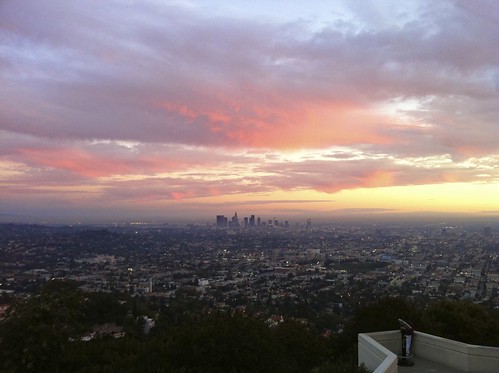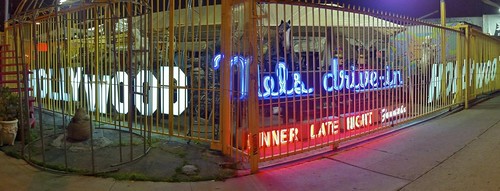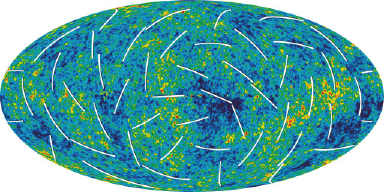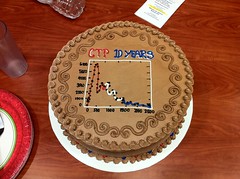One of the perks (perqs?) of academia is that occasionally I get an excuse to escape the damp grey of London Winters. The Planck Satellite is an international collaboration and, although largely backed by the European Space Agency, it has a large contribution from US scientists, who built the CMB detectors for Planck’s HFI instrument, as well as being significantly involved in the analysis of Planck data. Much of this work is centred at NASA’s famous Jet Propulsion Lab in Pasadena, and I was happy to rearrange my schedule to allow a February trip to sunny Southern California (I hope my undergraduate students enjoyed the two guest lectures during my absence).
Visiting California, I was compelled to take advantage of the local culture, which mostly seemed to involve meals. I ate as much Mexican food as I could manage, from fantastic $1.25 tacos from the El Taquito Mexicano Truck to somewhat higher-end fare at Tinga in LA proper. And I finally got to taste bánh mì, French-influenced Vietnamese sandwiches (which have arrived in London but I somehow haven’t tried them here yet). And I got to take in the view from the heights of Griffith Park:
 as well as down at street level:
as well as down at street level:
 And even better, I got to share these meals and views with old and new friends.
And even better, I got to share these meals and views with old and new friends.
Of course I was mainly in LA to do science, but even at JPL we managed to escape our windowless meeting room and check out the clean-room where NASA is assembling the Mars Science Lab:
The white pod-like structure is the spacecraft itself, which will parachute into Mars’ atmosphere in a few years, and from it will descend the circular “sky crane” currently parked behind it which will itself deploy the car-sized Curiosity Rover to do the real work of Martian geology, chemistry, climatology and (who knows?) biology.
 But my own work was for the semi-annual meeting of the Planck CTP working group (I’ve never been sure if it was intentional, but the name always seemed to me a sort of science pun, obliquely referring to the famous “CPT” symmetry of fundamental physics). In Planck, “CTP” refers to Cℓ from Temperature and Polarization: the calculation of the famous CMB power spectrum which contains much of the cosmological information in the maps that Planck will produce. The spectrum allows us to compress the millions of pixels in a map of the CMB sky, such as this one from the WMAP experiment (the colors give the temperature or intensity of the radiation, the lines its polarization), into just a few thousand numbers we can plot on a graph.
But my own work was for the semi-annual meeting of the Planck CTP working group (I’ve never been sure if it was intentional, but the name always seemed to me a sort of science pun, obliquely referring to the famous “CPT” symmetry of fundamental physics). In Planck, “CTP” refers to Cℓ from Temperature and Polarization: the calculation of the famous CMB power spectrum which contains much of the cosmological information in the maps that Planck will produce. The spectrum allows us to compress the millions of pixels in a map of the CMB sky, such as this one from the WMAP experiment (the colors give the temperature or intensity of the radiation, the lines its polarization), into just a few thousand numbers we can plot on a graph.
 OK, this is not a publishable figure. Instead, it marks the tenth anniversary of the first CTP working group telecon in February 2001 (somewhat before I was involved in the group, actually). But given that we won’t be publishing Planck cosmology data for another couple of years, sugary spectra will have to do instead of the real ones in the meantime.
OK, this is not a publishable figure. Instead, it marks the tenth anniversary of the first CTP working group telecon in February 2001 (somewhat before I was involved in the group, actually). But given that we won’t be publishing Planck cosmology data for another couple of years, sugary spectra will have to do instead of the real ones in the meantime.
The work of the CTP group is exactly concerned with finding the best algorithms for translating CMB maps into these power spectra. They must take into account the complicated noise in the map, coming from our imperfect instruments which observe the sky with finite resolution — that is, a telescope which smooths the sky at a scale from about half down to one-tenth of a degree — and with a limited sensitivity — every measurement has a little bit of unavoidable noise added to it. Moreover, in between the CMB, produced 400,000 years after the Big Bang, and Planck’s instruments, observing today, is the entire rest of the Universe, which contains matter that both absorbs and emits (glows) in the microwaves which Planck observes. So in practice we need to simultaneously deal with all of these effects when reducing our maps down to power spectra. This is a surprisingly difficult problem: the naive, brute-force (Bayesian), solution requires a number of computer operations which scales like the cube of the number of pixels in the CMB map; at Planck’s resolution this is as many as 100 million pixels, and there still are no supercomputers capable of doing the septillion (1024) operations in a reasonable time. If we smooth the map, we can still solve the full problem, but on small scales, we need to come up with useful approximations which take advantage of what we know about the data, usually taking advantage of the very large number of points that contribute, and the so-called asymptotic theorems which say, roughly, that we can learn about the right answer by doing lots of simulations, which are much less computationally expensive.
At the required levels of both accuracy and precision, the results depend on all of the details of the data processing and the algorithm: How do you account for the telescope’s optics and the pixelization of the sky? How do you model the noise in the map? How do you remove those pixels contaminated by astrophysical emission or absorption? All of this is compounded by the necessary (friendly) scientific competition: it is the responsibility of the CTP group to make recommendations for how Planck will actually produce its power spectra for the community and, naturally, each of us wants our own algorithm or computer program to be used — to win. So these meetings are as much about politics as science, but we can hope that the outcome is that all the codes are raised to an appropriate level and we can make the decisions on non-scientific grounds (ease of use, flexibility, speed, etc.) that will produce the high-quality scientific results for which we designed and built Planck — and have worked on it for the last decade or more.

One response to “Tacos and Power Spectra in LA”
Bluffing about Mars
Saturday afternoon I received a call from a news producer at the BBC — could I come talk about the Mars Science Laboratory, launched earlier that day. This was a tough question, publicity-monger though I am: I don’t actually know anything a…